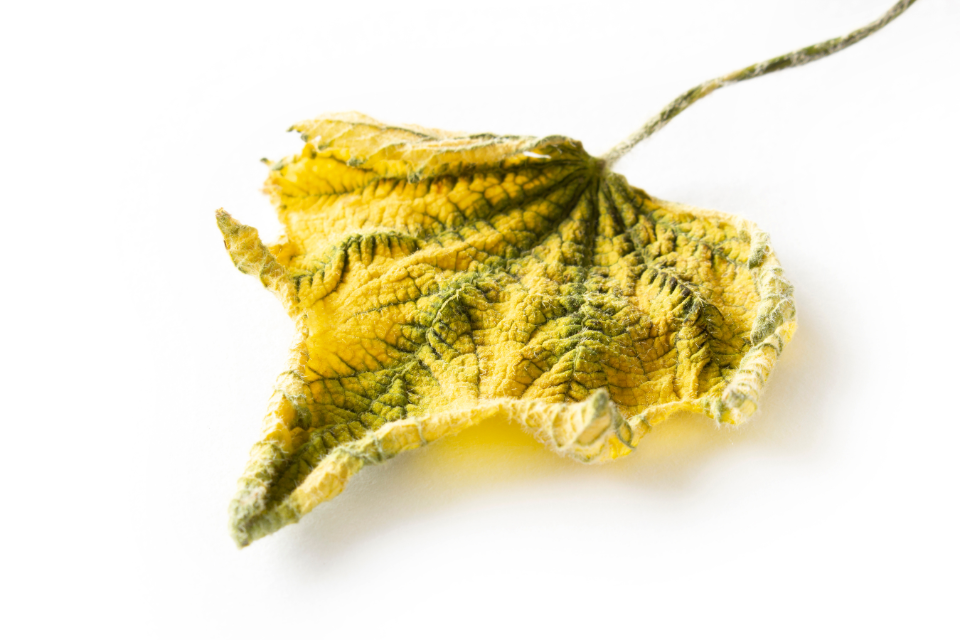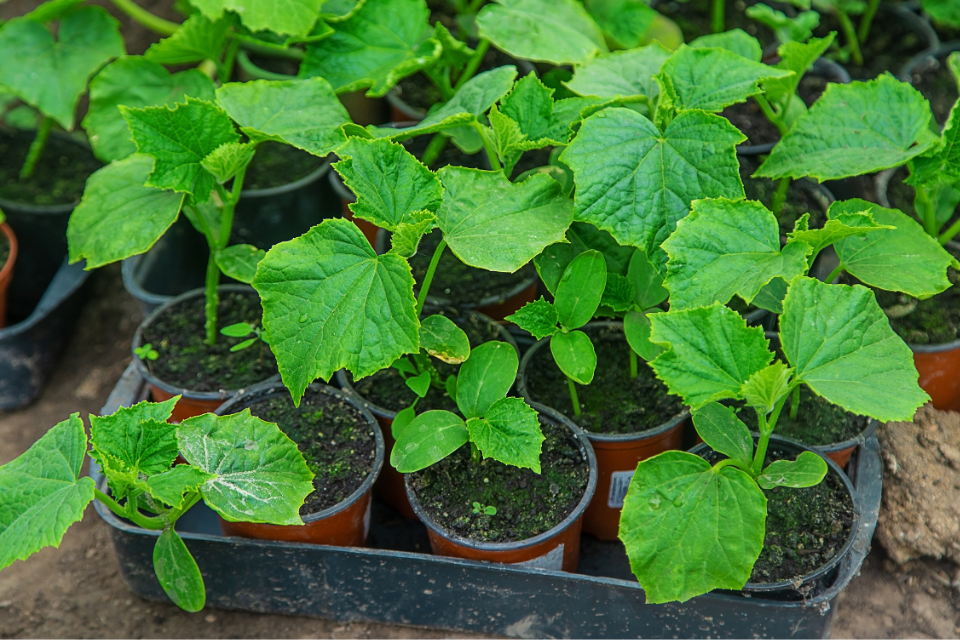Cucumber Leaves Turning Yellow: Causes & Solutions
Cucumbers are popular among gardeners because they’re versatile in the kitchen and easy to care for. However, noticing yellowing leaves on your cucumber plants could be a sign that something’s not right. This article examines why are your cucumber leaves turning yellow and offers practical solutions to keep cucumber plants thriving. Let’s figure out what’s happening to your cucumber plants.
What Causes Cucumber Leaves to Turn Yellow
Cucumber plants require specific conditions to flourish, including adequate sunlight, sufficient water, proper nutrients, and so on. If the conditions aren’t just right, cucumber plants can get sick. One common sign is yellowing leaves. Here are some common reasons for cucumber plant leaves turning yellow:
Incorrect Sunlight
Cucumber plants thrive in warm, sunny conditions and need at least six hours of direct sunlight daily. Insufficient light hinders their ability to produce enough energy through photosynthesis, leading to stunted growth and yellowing leaves from stress.
While cucumbers love sunlight, excessive sunlight, especially in high temperatures, can lead to leaf burn. Prolonged exposure to intense sunlight causes the plant to lose moisture rapidly, leading to dehydration and heat stress. This stress weakens the leaves, causing them to turn yellow, develop brown, crispy edges, and eventually dry out completely.
Underwatering and Overwatering
Underwatering can cause cucumber leaves to turn yellow because the plant becomes dehydrated. Without sufficient water, the plant struggles to maintain its normal functions, resulting in yellowing leaves, wilting, and eventual leaf drop.
On the other hand, overwatering can make the soil too soggy, which means less oxygen for the roots. This can lead to root suffocation and even root rot. This makes it harder for the plant to take up essential nutrients, which can cause leaves to turn yellow and the plant to decline.
Nutrient Deficiency
Essential nutrients are crucial for the plant’s overall health and metabolic functions. When cucumbers lack key nutrients, their ability to perform vital processes such as photosynthesis is impaired. Here are some common nutrient deficiencies that could be bothering your cucumber plants:
Nitrogen Deficiency: Nitrogen is a primary nutrient essential for chlorophyll production. Without enough nitrogen, the plants cannot produce sufficient chlorophyll, leading to pale or yellowing leaves, particularly starting with older, lower leaves.
Potassium Deficiency: Potassium helps regulate water uptake and enzyme activation. Potassium deficiency can cause leaf edges to turn yellow and brown, eventually leading to leaf drop. Not having enough potassium also makes the plant more vulnerable to disease and generally makes it less healthy.
Magnesium Deficiency: Magnesium is a central component of chlorophyll. Without it, leaves develop interveinal chlorosis, where the areas between the veins turn yellow while the veins themselves remain green.
Phosphorus Deficiency: Phosphorus is vital for energy transfer and photosynthesis in plants. When phosphorus is limited, the plant reallocates it to more crucial areas, causing leaves to turn yellow, especially the older leaves.
Pest Infestation
Another big reason for cucumber leaves turning yellow is that they’ve been invaded by pests. When certain pests munch on the leaves, they mess with the plant’s usual processes, which can cause all kinds of symptoms, including yellowing. Here are the main culprits:
Aphids: These small, sap-sucking insects can cause leaves to turn yellow by draining vital nutrients from the plant. Aphids can also transmit viruses, further contributing to yellowing and overall plant stress.
Spider Mites: These tiny arachnids suck sap from the leaves, leading to a stippled appearance and yellowing. Infestations can quickly weaken the plant and reduce its overall health.
Whiteflies: Whiteflies feed on the underside of cucumber leaves, causing them to turn yellow and curl. Like aphids, they can also transmit plant viruses that exacerbate yellowing and other symptoms.
Cucumber Beetles: Both the adult beetles and their larvae feed on cucumber plants, causing direct damage to the leaves. This feeding can lead to yellowing and wilting, and cucumber beetles are known to spread bacterial wilt and other diseases.
Thrips: These small insects feed on plant tissues and can cause leaves to turn yellow and develop a silver or speckled appearance. They also transmit various plant viruses, which can worsen the yellowing.
Diseases
Several diseases can also cause cucumber leaves to turn yellow. Here are a few common ones:
Powdery Mildew: This fungal disease causes a white, powdery coating on the leaves and stems. It thrives in dry conditions and can lead to leaf yellowing and reduced fruit production.
Downy Mildew: Caused by a different fungus, downy mildew produces yellow spots on the upper side of leaves and a fuzzy, grayish mold on the underside. It typically occurs in humid conditions and can cause significant leaf drop.
Bacterial Wilt: Transmitted by cucumber beetles, this disease causes wilting and yellowing of leaves as bacteria infect the plant’s vascular system, disrupting water and nutrient transport.
Cucumber Mosaic Virus(CMV): Causes mottled, yellowing leaves and stunted growth. It is spread by aphids and can significantly impact crop yield and quality.
Anthracnose: Results in sunken, dark lesions on leaves and fruit. The disease can lead to yellowing leaves and reduced fruit quality.
Angular Leaf Spot: A bacterial disease invades cucumbers, zucchini, melons, etc., creating water-soaked lesions that eventually develop into angular, brown spots with yellow halos. This disease causes irreversible damage to leaves and reduces yields.
How to Fix Cucumber Plant Leaves Turning Yellow
As mentioned, several factors can cause cucumber leaves to turn yellow. Identifying the exact cause is essential to applying the correct solution and effectively tackling the problem. In the following sections, we will outline specific remedies for each identified cause.
Correct Lighting
Your cucumber plants require at least six hours of direct sunlight daily. If you’re growing cucumbers outdoors, place them in the sunniest spot. However, if the sunlight is intense for extended periods, it’s important to provide shade to prevent sunburn on the plants.
If you are growing indoors, then an appropriate grow light can meet your plants’ needs perfectly. LED grow lights, which illuminate continuously for 12 hours, generate less heat compared to traditional HPS lights, reducing the likelihood of burning plants. They are also more energy-efficient, consuming less power, making them an excellent option for indoor cucumber cultivation.
Watering Properly
Cucumbers, being high in water content, require ample hydration to thrive. Using a hygrometer can help monitor soil moisture levels to measure if your plants are dehydrated.
Alternatively, you can check manually by inserting your index finger 1–2 inches into the soil near the plant’s base. If the soil feels dry at the first or second knuckle, it’s time to water. If it still feels moist, wait before watering.
Proper drainage is essential to prevent waterlogging. You can improve soil drainage by mixing in organic materials like compost or worm castings to boost drainage efficiency. For container-grown cucumber plants, make sure the pots have drainage holes at the bottom to allow excess water to escape.
Nutrient Management
If you notice yellowing leaves, begin by conducting a soil test to assess nutrient levels and identify any deficiencies. Based on the results, adjust your fertilizer application to correct these deficiencies.
Additionally, tailor the nutrient proportions to the plant’s growth stage. For example, increase nitrogen during the vegetative stage to promote leafy growth, and ensure adequate magnesium during the flowering stage to support healthy blooms.
Pest Control
Regularly check your cucumber plants for pests, as early detection is vital to preventing infestations. For effective control, apply insecticidal soap or neem oil for immediate elimination. Ensure full coverage, particularly on the undersides of leaves where pests commonly hide. If you discover heavily infested areas, promptly remove and discard affected leaves or sections to stop the spread.
Disease Prevention
Apply fungicides either as a preventive measure or at the first signs of disease. You can choose organic options like sulfur or copper-based fungicides, which are effective and environmentally friendly.
Additionally, ensure that there is ample air circulation around your plants. Adequate spacing and airflow help reduce humidity levels, creating an environment less conducive to fungal growth and further disease development.
Regularly monitoring your plants and maintaining proper cultural practices will enhance their resilience and overall health.
FAQs about Cucumber Leaves Turning Yellow
- Should I cut off yellow cucumber leaves?
Yes, removing yellow leaves helps your plants stay tidy, conserve energy, and manage pests and diseases. However, it’s important to keep in mind that if the yellowing is caused by factors like nutrient deficiencies or overwatering, simply removing the leaves won’t resolve the underlying issue.
- Why are my hydroponic cucumber leaves turning yellow?
Hydroponic cucumber leaves may turn yellow due to nutrient imbalances, poor water quality, insufficient oxygen, or environmental stress; ensure proper pH, nutrient levels, and water conditions to resolve these issues.
- How to treat yellow cucumber leaves with Epsom salt?
If you notice general yellowing of the leaves starting from the base of the plant, it may indicate a magnesium deficiency. The yellowing will be uniform across the leaf, with the green turning yellow throughout. To address this, mix about 2 tablespoons of Epsom salt per gallon of water and apply it using a sprayer or watering can. Soak both the leaves and the soil, as magnesium is quickly absorbed by the plant through its leaves.









